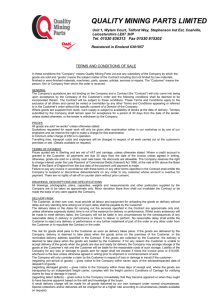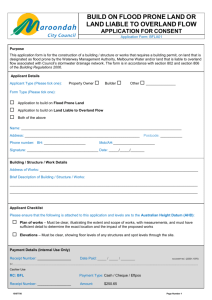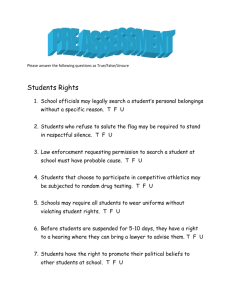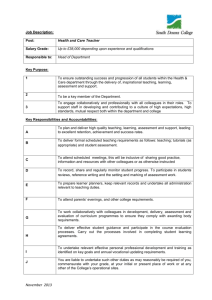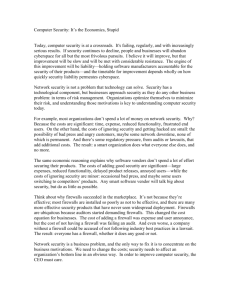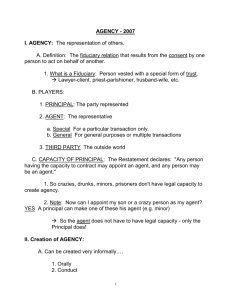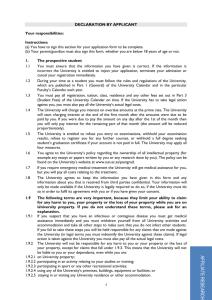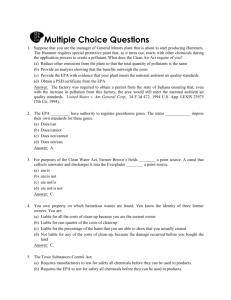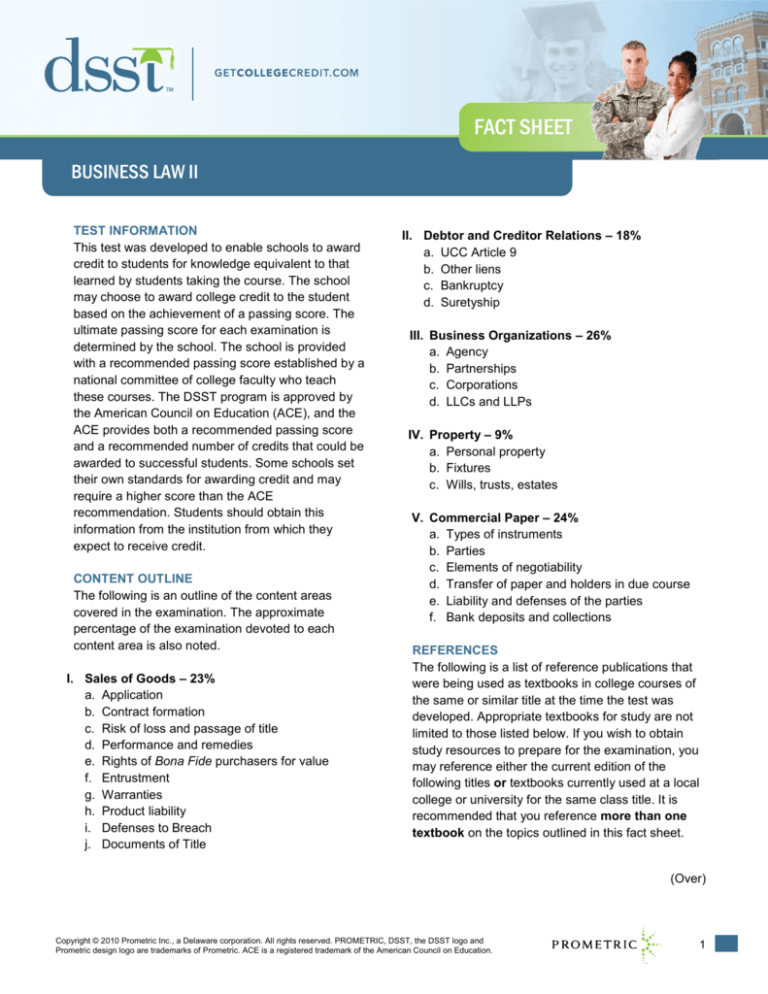
FACT SHEET
BUSINESS LAW II
TEST INFORMATION
This test was developed to enable schools to award
credit to students for knowledge equivalent to that
learned by students taking the course. The school
may choose to award college credit to the student
based on the achievement of a passing score. The
ultimate passing score for each examination is
determined by the school. The school is provided
with a recommended passing score established by a
national committee of college faculty who teach
these courses. The DSST program is approved by
the American Council on Education (ACE), and the
ACE provides both a recommended passing score
and a recommended number of credits that could be
awarded to successful students. Some schools set
their own standards for awarding credit and may
require a higher score than the ACE
recommendation. Students should obtain this
information from the institution from which they
expect to receive credit.
CONTENT OUTLINE
The following is an outline of the content areas
covered in the examination. The approximate
percentage of the examination devoted to each
content area is also noted.
I. Sales of Goods – 23%
a. Application
b. Contract formation
c. Risk of loss and passage of title
d. Performance and remedies
e. Rights of Bona Fide purchasers for value
f. Entrustment
g. Warranties
h. Product liability
i. Defenses to Breach
j. Documents of Title
II. Debtor and Creditor Relations – 18%
a. UCC Article 9
b. Other liens
c. Bankruptcy
d. Suretyship
III. Business Organizations – 26%
a. Agency
b. Partnerships
c. Corporations
d. LLCs and LLPs
IV. Property – 9%
a. Personal property
b. Fixtures
c. Wills, trusts, estates
V. Commercial Paper – 24%
a. Types of instruments
b. Parties
c. Elements of negotiability
d. Transfer of paper and holders in due course
e. Liability and defenses of the parties
f. Bank deposits and collections
REFERENCES
The following is a list of reference publications that
were being used as textbooks in college courses of
the same or similar title at the time the test was
developed. Appropriate textbooks for study are not
limited to those listed below. If you wish to obtain
study resources to prepare for the examination, you
may reference either the current edition of the
following titles or textbooks currently used at a local
college or university for the same class title. It is
recommended that you reference more than one
textbook on the topics outlined in this fact sheet.
(Over)
Copyright © 2010 Prometric Inc., a Delaware corporation. All rights reserved. PROMETRIC, DSST, the DSST logo and
Prometric design logo are trademarks of Prometric. ACE is a registered trademark of the American Council on Education.
1
You should begin by checking textbook content
against the content outline included on the front
page of this Fact Sheet before selecting textbooks
that cover the test content from which to study.
Textbooks may be found at the campus bookstore of
a local college or university offering a course on the
subject. You are not allowed to use these references
in the testing center.
1. Business Law: Principles, Cases, Legal
Environment, Anderson, R.A.; Fox, I.; and
Twomey, D.P. Cincinnati, OH: South-Western
Publishing Co., current edition.
2. Essentials of Business Law for a New Century,
Beatty, J.; and Samuelson, S. South-Western
Colege Publishing, current edition.
3. Business Law, Cameron III, G.D.; and Scalletta
Jr., P.J. San Diego, CA: Business Publications,
Inc., current edition.
4. West's Business Law, Clarkson, K.W.; Miller,
R.L.; and Jentz, G.A. Anaheim, CA: West
Publishing Co., current edition.
5. Principles of Business Law, Corley, R.N.;
Shedd, P.J.; and Holmes, E.M. Englewood
Cliffs, NJ: Prentice-Hall, Inc., current edition.
6. Principles of Business Law, Frascona, J.L.
Needham Heights, MA: Allyn and Bacon, current
edition.
7. Contemporary Business Law, Hoeber, R.C. et
al. New York: McGraw-Hill, current edition.
8. Business Law, Text and Cases, Howell, R.A.;
Allison, J.R.; and Henley, N.T. Hinsdale, IL: The
Dryden Press, current edition.
9. Business Law and the Regulatory Environment,
Metzger, M.B. et al. Homewood, IL: Richard D.
Irwin, Inc., current edition.
10. Business Law, Roszkowski, M.E. Glenview, IL:
Scott, Foresman & Co., current edition.
11. Smith and Roberson's Business Law, Smith,
L.N. et al. Anaheim, CA: West Publishing Co.,
current edition.
12. Current textbook used by a local college or
university for a course on the subject.
SAMPLE QUESTIONS
All test questions are in a multiple-choice format,
with one correct answer and three incorrect options.
You may want to review these samples for the type
of questions that may appear on the exam.
1. An endorser of a note makes transfer warranties
by doing which of the following?
a. Endorsing the note
b. Transferring the instrument to a holder for
value
c. Transferring the instrument for consideration
d. Presenting the note for payment
2. George Allen delivers to Alice Boyd a deed that
states, “I hereby transfer my farm, Blackacre, to
Alice Boyd for her lifetime.” The deed creates a
life estate in Alice Boyd and a
a. remainder in George Allen
b. remainder in Alice Boyd’s heirs
c. revision in George Allen
d. revision in Alice Boyd’s heirs
3. Andrew Abel is working for Nancy Pierce. During
the course of the agency relationship, Abel
executes negotiable instruments for Pierce.
Which of the following signatures will always
expose Abel to personal liability on the
instruments?
a. Andrew Abel, Agent for Nancy Pierce
b. Andrew Abel, Agent
c. Andrew Abel, Nancy Pierce
d. Andrew Abel
4. Arnold Victor sold an airplane to Marian Sayles.
Victor misrepresented the number of flying hours
on the plane, stating that it had 1,800 hours
when he knew the correct figure was 18,000
hours. Sayles put an additional 200 hours of
flying time on the airplane, and then put it up for
sale. Having believed Victor's misrepresentation,
Sayles told Pat Boyer that the airplane had only
2,000 hours of flying time. Boyer then purchased
the airplane for $25,000. After discovering the
true amount of flying time, Boyer sued Sayles for
breach of express warranty and fraud. What
liability does Sayles have to Boyer?
a. Sayles is liable for breach of express
warranty relative to the number of flying
hours because such a warranty does not
depend upon what Sayles knew.
(Over)
2
b. Sayles is liable because the
misrepresentation by her concerning the
number of flying hours constitutes fraud.
c. Sayles is not liable if the term “warranty”
was never expressly used by her.
d. Sayles is not liable because she did not
know that the statement regarding the
number of hours was false.
5. Walter Brown is planning a winter camping trip
to the Yukon. He contacts Do-Rite Hardware
Store to purchase a sleeping bag fit for extreme
cold. He informs the salesperson of his
upcoming trip and asks for a recommendation.
The salesperson selects a bag manufactured by
Arctic Outfitters, designed for general use and
not adequate for extreme cold. Brown buys the
sleeping bag and uses it on his camping trip. As
a result, he suffers frostbite and sues Do-Rite
and Arctic for breach of warranty. Which of the
following statements regarding the defendants’
liability is correct?
a. Arctic is liable for breach of the warranty of
merchantability
b. Do-Rite is liable for breach of the warranty of
merchantability
c. Arctic is liable for breach of the warranty of
fitness for a particular purpose
d. Do-Rite is liable for breach of the warranty of
fitness for a particular purpose
6. Alfred, Baker, Cooper, and Dubold were general
partners in a CPA firm. Dubold decided to retire
and Ephram was brought in as a new partner.
Mary Smith, a client of the previous partnership,
sued Alfred, Baker, Cooper, Dubold, and
Ephram for accounting malpractice which had
occurred while Dubold was a partner but before
Ephram became a partner. Assuming Smith's
claim is valid and that she will prevail, who is
liable?
a. Alfred, Baker, and Cooper only are jointly and
severally liable.
b. Alfred, Baker, and Cooper only are jointly and
severally liable, and Ephram is liable up to
the amount of Ephram’s capital contribution.
c. Alfred, Baker, Cooper, and Dubold only are
jointly and severally liable.
d. Alfred, Baker, Cooper, and Dubold are jointly
and severally liable, and Ephram is liable up
to the amount of Ephram’s capital
contribution.
7. The driver of a Fastest, Inc. delivery truck,
knowing Fastest’s policy against careless
driving, negligently ran a stop sign while making
a delivery and caused an accident with Ashford.
Ashford sues Fastest and the driver for injuries
and damages. Which of the following statements
is true regarding who is liable and why?
a. The driver is liable, but Fastest is not
because it has a policy against careless
driving by its employees.
b. The driver is liable, but Fastest is not
because the driver is an independent
contractor.
c. Fastest is liable, but the driver is not because
an employee is released from liability once
the liability of the employer has been
established.
d. Both the driver and Fastest are liable
because the driver is an employee and is
operating within the scope of his
employment.
8. Warren Simmons is a surety for Angela Neddle,
who owes $500,000 to Wallie Celette. The debt
is now due. Although able to pay, Neddle
refuses to do so for no good reason. Celette
seeks payment from Simmons, who will have to
sell his real estate at great loss to cover
Neddle’s debt. Simmons can avoid this difficulty
by resorting to a surety’s right of
a. reimbursement
b. subrogation
c. contribution
d. exoneration
9. Which of the following is true about a negotiable
instrument that is endorsed “Pay to Steve Solar
and only Steve Solar”?
a. It is ineffective to transfer the instrument.
b. It destroys negotiability of the instrument.
c. It prevents further transfer of the instrument.
d. It permits further transfer by Steve Solar.
(Over)
3
10. On May 1, Steve Sterling drew a negotiable
check payable to his landlord, Carol Baker, for
$400. The check was drawn on Allston Bank.
The landlord misplaced the check and then
found it on June 15. On June 16 she endorsed
the check and deposited it into her account at
Security Bank. Which of the following
statements is true?
a. Sterling is discharged from liability on the
check.
b. Allston Bank does not have to honor the
check because it is stale.
c. Allston Bank is the depository bank.
d. Allston Bank must honor the check if
Sterling’s account contains sufficient funds.
Answers to sample questions: 1-C; 2-C; 3-D; 4-A; 5-D;
6-D; 7-D; 8-D; 9-D; 10-D.
CREDIT RECOMMENDATIONS
The Center for Adult Learning and Educational
Credentials of the American Council on Education
(ACE) has reviewed and evaluated the DSST test
development process for and content of this exam. It
has made the following recommendations:
Area or Course
Equivalent
Level
Business Law II
Amount of
Credit
Source
Three (3) semester hours
Upper-level baccalaureate
ACE Commission on
Education Credit and
Credentials
It is advisable that schools develop a consistent
policy about awarding credit based on scores from
this test and that the policy be reviewed periodically.
Prometric will be happy to help schools in this effort.
Rev. 20100316 - I.N. 390534
4



